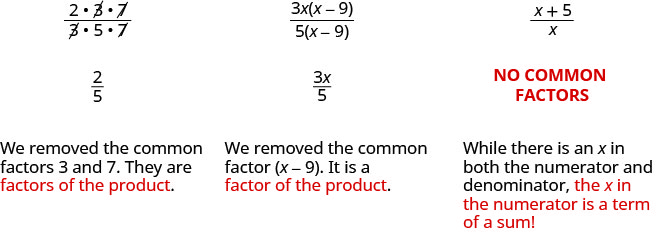7.1: Simplify Rational Expressions
- Page ID
- 30949
Summary
By the end of this section, you will be able to:- Determine the values for which a rational expression is undefined
- Evaluate rational expressions
- Simplify rational expressions
- Simplify rational expressions with opposite factors
Are you Ready?
Before you get started, take this readiness quiz.
If you miss a problem, go back to the section listed and review the material.
In Chapter 1, we reviewed the properties of fractions and their operations. We introduced rational numbers, which are just fractions where the numerators and denominators are integers, and the denominator is not zero.
In this chapter, we will work with fractions whose numerators and denominators are polynomials. We call these rational expressions.
Definition: RATIONAL EXPRESSION
A rational expression is an expression of the form \(\frac{p(x)}{q(x)}\), where p and q are polynomials and \(q \ne 0\).
Here are some examples of rational expressions:
\[\begin{array}{cccc} {−\frac{13}{42}}&{\frac{7y}{8z}}&{\frac{5x+2}{x^2−7}}&{\frac{4x^2+3x−1}{2x−8}}\\ \nonumber \end{array}\]
Notice that the first rational expression listed above, \(−\frac{13}{42}\), is just a fraction. Since a constant is a polynomial with degree zero, the ratio of two constants is a rational expression, provided the denominator is not zero.
We will perform same operations with rational expressions that we do with fractions. We will simplify, add, subtract, multiply, divide, and use them in applications.
Key Concepts
- Determine the Values for Which a Rational Expression is Undefined
- Set the denominator equal to zero.
- Solve the equation, if possible.
- Simplified Rational Expression
- A rational expression is considered simplified if there are no common factors in its numerator and denominator.
- Simplify a Rational Expression
- Factor the numerator and denominator completely.
- Simplify by dividing out common factors.
- Opposites in a Rational Expression
- The opposite of a−b is b−a
\(\frac{a−b}{b−a}=−1\) \(a \ne b\), \(b \ne 0\), \(a \ne b\)
- The opposite of a−b is b−a
Glossary
- rational expression
- A rational expression is an expression of the form \(\frac{p}{q}\), where p and q are polynomials and \(q \ne 0\).



































